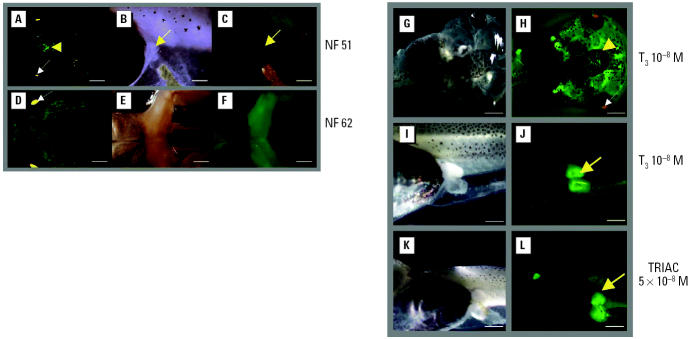Figure 5.
(A–F) Transcription responses of the TRE-containing transgene to endogenous TH induced by natural metamorphosis in germinally transgenic F0 embryos at NF stages 51 (A–C) and 62 (D–F). (A, D) Brain. (B–F) Limb buds. TH/bZIP-eGFP is expressed first in the brain (A, yellow arrowhead) and then in other tissues, and persists throughout larval development (A, D). No fluorescence above background is present in limb buds at NF stage 51 (C, yellow arrow). The signal increases throughout larval development until metamorphosis is reached (NF stage 62), when it increases strongly (F). Bars = 1.6 mm (A); 0.5 mm (B, C); 1.8 mm (D); 1.7 mm (E, F).
(G–L) The pretreatment protocol significantly reduced time for response to T3 and to TH analogues in TH/bZIP-eGFP transgenic F0 tadpoles (G, H, head; I–L, hindlimb). Tadpoles were pretreated for 24 hr with 10−12 M T3 at NF stages 51–52, and then rinsed and fed during 24 hr before being exposed to 10−8 M T3 (J) or to 5 × 10−8 M TRIAC (L). Fluorescence in the CNS (H) and in hindlimb buds (J, L) was observed after 2 days of treatment. Yellow arrows indicate limb buds; arrowhead indicates the brain area. White arrows indicate crystallin-RFP expression in the eye. Bars = 2 mm (G, H); 0.8 mm (I–L).

